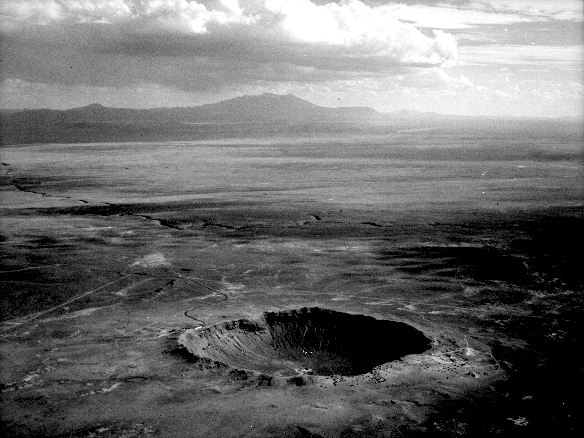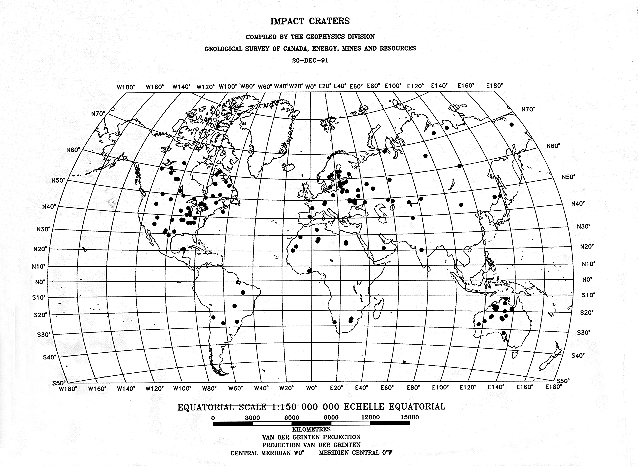


|
| |||||||||



Significant attention by the scientific community to the hazard began in 1980
when Luis Alvarez and others prposed that such an impact, and the resulting global pall of dust, resulted in the mass extinctions of lifeforms on Earth, ending the age of dinosaurs (Alvarez and others, 1980). Additional papers and discussion in the scientific literature followed, and widespread public interest was aroused. In 1981, NASA organized a workshop
'Collision of Asteroids and Comets with the Earth: Physical and Human
Consequences' at Snowmass, Colorado (July 13-16, 1981). Asummary of the principal conclusions of the workshop report appeared in the book Cosmic Catastrophes
(Chapman and Morrison, 1989a) and in a presentation by Chapman and Morrison(1989b) at an American Geophysical Union Natural Hazards Symposium. In response to the close passage of asteroid 1989FC, the American Institute of Aeronautics and Astronautics (AIAA, 1990) recommended studies to increase the detection rate of near-Earth asteroids, and how to
prevent such objects striking the Earth. The AIAA brought these
recommendations to the attention of the House Committee of Science, Space, and
Technology, leading to the Congressional mandate for this workshop included in
the NASA 1990 Authorization Bill. In parallel with these political
developments, a small group of dedicated observers significantly increased the
discovery rate of Near-Earth asteroids and comets, and several of these
discoveries were highlighted in the international press. Other recent
activity has included the 1991 International Conference on Near-Earth
Asteroids (San Juan Capistrano, California, June 30 - July 3), a meeting on
the 'Asteroid Hazard' held in St. Petersburg, Russia (October 9-10, 1991), and
a resolution endorsing international searches for NEO's adopted by the
International Astronomical Union (August 1991).
Despite a widespread perception that asteroid impact is a newly recognized hazard, the basic nature of the hazard was roughly understood half a century ago. In 1941, Fletcher Watson published an estimate of the rate of impacts on the Earth, based on the discovery of the first three Earth-approaching asteroids (Apollo, Adonis, and Hermes). A few years later, Ralph Baldwin (1949), in his seminal book The Face of the Moon, wrote

Watson and Baldwin (both of whom are still alive) were prescient, but in
their time few other scientists gave much thought to impacts on the Earth.
Recently, however, there has been a gestalt shift that recognizes
extraterrestrial impact as a major geological process and, probably, an
important influence on the evolution of life on our planet. Also new is our
capability to detect such objects and to develop a space technology that could
deflect a potential projectile before it struck the Earth.
Go to: [Table of Contents] [Next Section] [Previous Section] [Top of Current Chapter]
'The chances of the Earth being struck by a large asteroid are extremely small, but since the consequences of such a collision are extremely large, the Committee believes it is only prudent to assess the nature of the threat and prepare to deal with it. We have the technology to detect such asteroids and to prevent their collision with the Earth.
'The Committee therefore directs that NASA undertake two workshop studies. The first would define a program for dramatically increasing the detection rate of Earth-orbit-crossing asteroids; this study would address the costs, schedule, technology, and equipment required for precise definition of the orbits of such bodies. The second study would define systems and technologies to alter the orbits of such asteroids or to destroy them if they should pose a danger of life on Earth. The Committee recommends international participation in these studies and suggests that they be conducted within a year of the passage of this legislation.'

The present report of the NASA International Near-Earth Object Detection Workshop is the direct result of this Congressional request to NASA. A second NASA workshop on the question of altering asteroid orbits is scheduled for 1992.
The NASA International Near-Earth Object Detection Workshop was organized in the spring of 1991 and held three formal meetings: on June 30 - July 3 at the San Juan Capistrano Research Institute, on September 24-25 at the NASA Ames Research Center, and on November 5 in Palo Alto, California. The group has the following membership of 24 individuals from four continents.
Go to: [Table of Contents] [Previous Section] [Top of Current Chapter]

FIGURE 1.4. Approximately 130 terrestrial impact craters have been
identified. They range up to 140 to 200 km in diameter and from recent
to about two billion years in age. More craters have been identified in
Australia, North America, and eastern Europe partly because these areas
have been relatively stable for considerable geologic periods,
thus preserving the early geologic record, and because active search programs
have been conducted in these areas.
About 90 percent of the potential Earth-impacting projectiles are near-Earth asteroids or short-period comets, called collectively NEOs (Near Earth Objects). The other 10 percent are intermediate or long-period comets (those with periods longer than 20 years), which are treated separately since they they spend so little time in near-Earth space. The NEOs have orbits that closely approach or intersect that of the Earth. Their normal orbital motion brings them relatively near the Earth at intervals of a few years, permitting their discovery. The objective of an NEO survey is to find these objects during their periodic approaches to the Earth, to calculate their long-term orbital trajectories, and to identify any that may impact the Earth over the next several centuries. If any appear to be on Earth-impact trajectories, there will generally be a period of at least several decades during which to take corrective action. It should be emphasized that we are not discussing either a short-range search nor a quick-response defense system. The chance that an NEO will be discovered less than a few years before impact is vanishingly small. The nature of the NEO orbits allows us to carry out a deliberate, comprehensive survey with ample time to react if any threatening NEO is found. In contrast, however, the warning time for impact from a long-period comet might be as short as two years, requiring a different class of response.
In order to carry out a deliberate and comprehensive search, we must detect, over a period of a decade or more, the NEOs larger than our 1-km size threshold that pass near the Earth. This requires that we monitor a region of space extending outward from the orbit of the Earth approximately as far as the inner edge of the main asteroid belt, at a distance of 200 million kilometers. The easiest way to detect these NEOs is by observing their reflected sunlight, although they can also be seen in the infrared using their emitted thermal radiation. More exotic technologies are not appropriate; radar, in particular, is limited to targets close to the Earth, and so is unsuitable to a survey extending 200 million kilometers into space. In principle, the survey could be carried out either from the ground or from orbit. The brightness of a 1-km NEO at 200 million kilometers, assuming a reflectivity of 3 percent or more, corresponds to stellar magnitude 22. Although they are quite faint, such objects are readily detectable with conventional ground-based telescopes and can be distinguished from background stars by their characteristic motion. Thus there is no requirement for a more expensive space-based system. This brightness limit also determines the minimum telescope aperture of about 2 m that is required for a complete survey. Thus we have it within our current capability to construct a network of survey telescopes at relatively modest cost that can discover and track essentially all of the NEOs greater than 1 km in diameter. In addition, this same network of optical survey telescopes will be capable of detecting most incoming intermediate- or long-period comets and determining if any of them is has the potential to strike the Earth. However, the time between detection and possible impact will be much shorter for the long-period comets, probably no more than two years.
The survey program described in this report has the potential to alter fundamentally the way we view the threat of cosmic impacts. To date we have talked about a relatively undefined threat, to be discussed in terms of probabilities or statistical risks. While we know that such impacts must take place from time to time, we do not know if there are any specific bodies in space might impact the Earth over the next few centuries. If this search program is carried out, however, we can answer this question to at least the 75 percent confidence level. If such an object is found, then we can turn our attention to dealing with the threat it poses. In other words, we have the capability for at least a 75 percent reduction in the hazard posed by cosmic impacts.
|
| |||||||||